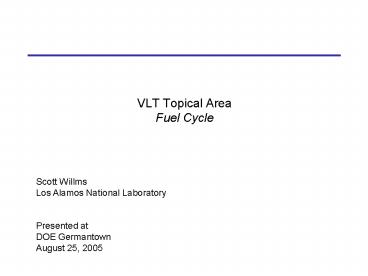VLT Topical Area Fuel Cycle - PowerPoint PPT Presentation
1 / 18
Title:
VLT Topical Area Fuel Cycle
Description:
Handling: Tritium's unique properties lead to materials compatibility and containment issues ... Dual Coolant Lead Lithium TBM tritium processing overview. Use ... – PowerPoint PPT presentation
Number of Views:60
Avg rating:3.0/5.0
Title: VLT Topical Area Fuel Cycle
1
VLT Topical AreaFuel Cycle
Scott Willms Los Alamos National
Laboratory Presented at DOE Germantown August
25, 2005
2
Fuel Cycle VLT Mission and Scope
- Mission
- To research, develop and design safe and
effective tritium processing systems needed to
accomplish the OFES mission
- Scope
- Separations Many unique separations are required
for tritium impurities processing, isotope
separation, purification, and gas and water
detritiation - Storage and delivery Isotopes must be safely
stored and delivered to systems as needed - Effluent cleanup High efficiency cleanup systems
are needed to prevent worker public exposure - Analysis A variety of analyses are required for
process monitoring, inventory control and
contamination control - Handling Tritiums unique properties lead to
materials compatibility and containment issues - Control Unique control issues arise from the
challenge of producing on-spec product with this
radioactive material while maintaining minimal
inventory
3
Key RD thrust areas over the next five years
- Thrust 1 Fuel cycle dynamic modeling
- Thrust 2 Permeation-based separations
- Thrust 3 TEP supporting research
- Thrust 4 Tritium separation and control in
blanket systems - Thrust 5 Continuously regenerable cryopump
- Thrust 6 Water detritiation
- Thrust 7 In-vessel tritium removal/processing
- Thrust 8 Tritium accountability
4
Description of RD Thrusts
5
Thrust Area 1 Fuel cycle dynamic modeling
- ITER Tritium Plant risk assessment performed
- The most striking observation is that, compared
to present experience, the ITER Tritium Plant is - 10xs flowrate (or more)
- 10xs inventory (or more)
- 1/10th the processing time
6
Industrial-class dynamic simulation needed
- Roles for a Tritium Plant dynamic model
- Process design
- Scale-up
- Control
- Tritium inventory
- Fundamental understanding
- Knowledge capture
- Training
7
Thrust Area 2 Permeation-based separations
- Baseline has been cryogenic molecular sieve.
Considerable work performed on this. - However, cryogenic molecular sieve is 77 K and
blanket is around 700 K - During ITER EDA discovered that Pd/Ag permeators
can be used to remove small amounts of tritium in
inert gases
- Equipment layout needed now
- Experimental testing needed at blanket conditions
- Tritium migration in TBM needs evaluation
8
Thrust Area 2 Permeation-based separations
- Low concentration tritium from helium
- Primary stream e.g. ceramic breeder
- Secondary stream e.g. heat exchanger permeate
- Low concentration tritium in liquid breeder (e.g.
PbLi) - Tritium bound in chemical forms (link to Thrust
area 4) - Membrane reactor
- Superior membranes
- Superior geometries
9
Dual Coolant Lead Lithium TBM tritium processing
overview
Recover tritium from He
Tritium control important throughout
Also use as test station
Use He to strip T from PbLi
PbLi loop
He loop
T permeation thru HX tubes
Recover tritium from He
Avg. T2 breeding rate 0.024 sccm
He loop
10
Task Area 3 TEP supporting research
- Current TEP design has only been tested at FzK,
and they have not performed integrated testing
(this is planned) - Indications that fundamental parameters have not
been tested - These parameters are particularly important for
scale-up - May need H/D testing of reactor/permeator train
to determine parameters
11
Palladium Membrane Reactor
- CD-1 review encouraged considering alternates to
present ITER TEP design. PMR possibly shrinks
and simplifies the TEP. - PMR recently chosen for industrial application
and design completed - New industrial membranes may improve performance
12
Task Area 4 Tritium separation and control in
blanket systems
- Primary separation method evaluation Bubble
column, permeator, disengager, oxidation/adsorptio
n, etc. - Fate and control evaluation System design,
barriers, etc.
13
Extraction strategy depends on tritium
migration paths
- Large surface area in heat exchanger (req. for
heat exchange) results in large loss of tritium
through heat exchanger - Must process cool side of heat exchanger
- Need tritium extractor in main loop?
14
Task Area 5 Continuously regenerable cryopump
- Completed initial tests of pump with H and D, and
He - Successfully fed up to 40 SLPM (current ITER
exhaust rate is 91 SLPM)
15
Task areas 6-8
- Thrust Area 6 Water detritiation (EU?)
- Thrust Area 7 In-vessel tritium
removal/processing (mostly other program
elements/other parties) - Tritium removal
- Tritium processing
- Thrust Area 8 Tritium accountability (EU/ITER?)
16
Current spending on RD Thrusts
- No VLT fuel cycle funding
17
Characterization of RD thrusts to VLT missions
18
Summary
- Fuel cycle research is needed
- To ensure the success of ITER
- To learn from the opportunities afforded by ITER
- To face the new challenges of tritium breeding
- To lay the groundwork for future machines
- Work in many of the fuel cycle areas requires a
unique skill set. This skill set is broadly
applicable to other subsystems.































